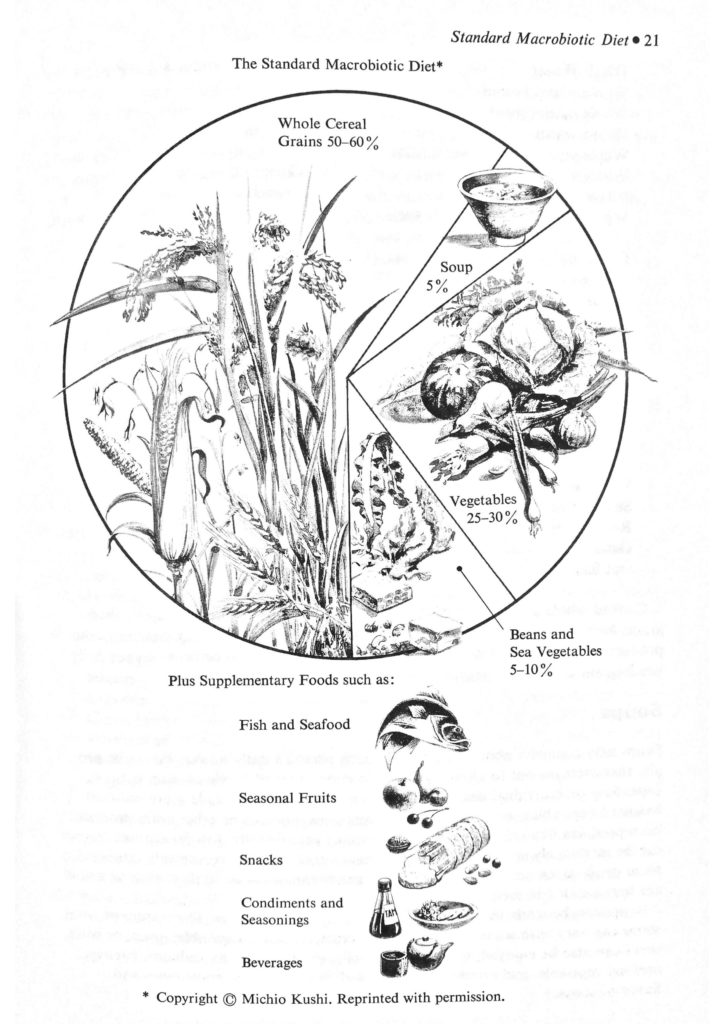Imagine that you want to eat healthy.
Where would you start from?
Michio Kushi proposed the standard macrobiotic diet as a starting point.
If you want to eat healthy, you should know two things:
(1) What the standard macrobiotic diet consists of.
(2) Learning how to adapt yourself to it. A macrobiotic counselor will do it for you.
We will focus on the first bullet point today:
In order to show you what the standard macrobiotic diet is, I am going to use fragments from a book written by Michio and Aveline Kushi in 1986: Macrobiotic Child Care & Family Health. Once you read it, you know much more about macrobiotics.
It says the following:
In general, an optimally balanced diet in a temperate, or four-season, climate consists of the following proportions of food:
1. Whole Cereal Grains
We recommend that cooked whole grain cereals comprise at least half (50 percent) of every meal. Cooked whole grains are preferable to flour products as they are easier to digest. Whole grains for daily use include: Brown rice (short grain is preferable in temperate climates), millet, barley, corn, whole oats, wheat berries, and rye. Whole grains for occasional use include: sweet brown rice, mochi (pounded sweet brown rice), whole wheat noodles (including udon and somen), buckwheat, buckwheat noodles (soba) unleavened whole wheat or rye bread, or unleavened bread made from other whole grains, rice cakes, cracked wheat, bulgur, steel cut and rolled oats, corn grits and meal, rye flakes, and couscous. In general, it is better to keep the intake of flour products, flaked cereals, and products such as couscous and grits below 20 percent of the daily proportion of whole grains.
2. Soups
One or two cups or small bowls of soup may be included daily. We recommend seasoning soups with a moderate amount of miso, tamari soy sauce, or sea salt, so that they taste neither too salty nor too bland. Soups may be prepared with a variety of ingredients including seasonal vegetables, sea vegetables -especially wakame and kombu- and grains and beans. Barley miso, also known as mugi miso, is generally better for regular use, while soybean (Hatcho) and brown rice (genmai) miso may be used on occasion.
3. Vegetables
About one-quarter (25-30 percent) of each meal may include vegetables prepared in a variety of ways, including steaming, boiling, pressure-cooking, and others. In general, up to one-third of your daily vegetable intake may be eaten in the form of macrobiotically prepared pickles or salad. We recommend avoiding commercial dressings and mayonnaise.
4. Beans, Bean Products, and Sea Vegetables
About 5 to 10 percent of your daily diet may include cooked beans, bean products, and sea vegetables. Beans for regular use include: Azuki beans (small red bean), chickpeas, and lentils. Beans for occasional use include: Black-eyed peas, black turtle beans, black soybeans, kidneys beans, great northern beans, whole dried peas, split peas, pinto beans, lima beans, and navy beans. Fermented bean products such as tempeh (an Indonesian fermented soybean product), tofu (soybean curd), dried tofu, and natto (fermented soybean) may also be included on a regular basis. (Naturally processed whole wheat products like seitan [seasoned wheat gluten] and fu [dried wheat gluten] may also be used in various side dishes from time to time).
5. Supplementary foods
Depending upon age, condition and type of activity, a small amount of whitemeat fish or seafood may be eaten once or twice a week. Suitable varieties include: flounder, halibut, sole, carp, haddock, trout, clams, oysters, smelt, scallops, shrimp, chirimen, iriko (tiny dried fish), and chuba (small dried fish).
A small volume of roasted seeds, lightly seasoned with sea salt or tamari, may be enjoyed as snacks by adults and older children. Suitable varieties include: Sesame, sunflower, pumpkin, and squash seeds.
Desserts may be enjoyed now and then, generally about two to three times per week. Unsweetened, cooked fruit desserts are preferable. However, small amounts of high quality natural grain sweeteners such as rice syrup, barley malt or amasaké (slightly fermented sweet brown rice) may be added occasionally. Dried and fresh local fruits in season may also be enjoyed from time to time by those in good health.
6. Beverages
It is recommended that spring or well water de used in the preparation of teas and other beverages. Beverages for daily use include: Bancha twig tea (kukicha), bancha stem tea, roasted rice tea, roasted barley tea, boiled water, and spring or well water.
7. Condiments
Condiments may be used in moderate amounts to add a variety of flavors to foods and to provide additional nutrients. The following condiments may be used by adults and older children: Tamari soy sauce, sesame salt (gomashio), roasted sea vegetable powder, sesame seed powder, umeboshi plum, shio (salt) kombu, nori condiment, tekka, sauerkraut. Other condiments for occasional use include: Pickles, vinegar, ginger.
8. Oil and Seasoning
It is best to use only a moderate amount of high quality, cold pressed vegetable oil in cooking. It is generally advisable to limit the intake of sautéed vegetables and other dishes which contain oil several times per week, and to use only a small amount of oil when preparing those dishes. Oil may be used occasionally in deep-frying grains, vegetables, fish, and seafood. Oils for regular use include: Sesame, dark sesame, and corn oil.
Naturally processed, unrefined sea salt is preferred over other varieties of seasoning. Miso and tamari soy sauce, both of which contain salt, may also be used. Seasoning that can be used regularly by adults and older children include: Miso, tamari soy sauce, white sea salt, umesboshi plum or paste, umeboshi vinegar, and rice or other grain vinegar.
9. Foods to reduce or avoid in temperate climates according to vintage macrobiotics:
- Animal products: red meat, poultry, wild game, eggs.
- Dairy products: cheese, butter, milk, yogurt, kefir, ice cream, sour cream, whipped cream
- Fish: red meat or blue-skinned fish
- Processed foods: instant foods, canned foods, frozen foods, white flour, white rice, foods processed with chemicals, additives, preservatives, stabilizers, emulsifiers, artificial coloring, sprayed, dyed foods.
- Sweeteners: sugar, honey, molasses, corn syrup, saccharine, fructose, carob, maple syrop, chocolate.
- Stimulants: spices, herbs, vinegar, coffee, alcohol, commercially dyed teas, stimulating aromatic teas, ginseng.
- Fats: lard or shortening, processed vegetables oils, soy margarines.
- Nuts: brazil, cashew, pistacho, hazel.
- Tropical fruits-beverages: artificial beverages, bananas, grapefruit, mangoes, oranges, papayas, figs, prunes, coconut, kiwi.
NOTES
[1] Book used to write the post: Michio and Aveline Kushi (1986). Macrobiotic Child Care & Family Health. Tokyo and New York: Japan Publications, Inc.
[2] Image of the post from the book: Kushi, A. and Esko, W. (1989). Aveline Kushi´s Wonderful World of Salads. Tokyo and New York: Japan Publications, Inc.


40 years ago whilst living with some macrobiotic friends, we regularly ate a delicious dish of fish , brown rice and tamari , all cooked together in one pot. All I remember is that it had 6 tablespoons of tamari!
Can you help me rediscover the recipe. Thanks
Hi Soo,
I will help you to re-discover the recipe. I am passionate on macrobiotics and it is an exciting challenge for me. I will email you back as soon as I know anything. Thanks for your message!
Best regards
Mario Lopez Pomares
Dietitian, Psychologist, and founder of Macrobiotic School
and Macrobiotica Mediterranea
Good morning,
I am looking for resources on kidney healt (frequent urination at night). Lino Stanchich’s book on this topic is not available on Amazon anymore.
Best wishes
Sabine Scheucher
Hi Sabine,
I don’t know any macrobiotic book about kidney health only. But you’ll find interesting notes in the book The Macrobiotic Path To Total Health (2003), that is avaible these days.
Best wishes
Mario